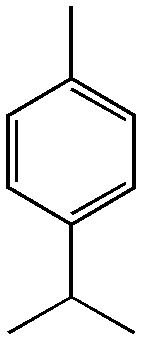P-Cymene
P-Cymene is a naturally occurring monoterpene that is found in over 100 plant species. It is a colorless liquid with a pleasant, aromatic odor and is used in the flavor and fragrance industry. P-Cymene is also used as a precursor in the synthesis of other compounds in the chemical industry.
Chemical Structure[edit | edit source]
P-Cymene has the chemical formula C10H14. It is a hydrocarbon consisting of a benzene ring substituted with a methyl group (CH3) and an isopropyl group (CH(CH3)2). The presence of these groups gives p-cymene its unique chemical properties.
Natural Occurrence[edit | edit source]
P-Cymene is found in a variety of plants including cumin, thyme, and oregano. It is also found in the essential oils of a variety of other plants. The concentration of p-cymene in these oils can vary greatly depending on the plant species and the method of extraction used.
Uses[edit | edit source]
P-Cymene is used in the flavor and fragrance industry due to its pleasant, aromatic odor. It is also used as a precursor in the synthesis of other compounds in the chemical industry. For example, it is used in the synthesis of thymol, a compound with antiseptic properties.
Health Effects[edit | edit source]
P-Cymene is generally considered safe for consumption and is used in the food industry as a flavoring agent. However, like all chemicals, it can be harmful in large amounts. It is important to use p-cymene and products containing it responsibly.
See Also[edit | edit source]
References[edit | edit source]
Search WikiMD
Ad.Tired of being Overweight? Try W8MD's physician weight loss program.
Semaglutide (Ozempic / Wegovy and Tirzepatide (Mounjaro / Zepbound) available.
Advertise on WikiMD
|
WikiMD's Wellness Encyclopedia |
| Let Food Be Thy Medicine Medicine Thy Food - Hippocrates |
Translate this page: - East Asian
中文,
日本,
한국어,
South Asian
हिन्दी,
தமிழ்,
తెలుగు,
Urdu,
ಕನ್ನಡ,
Southeast Asian
Indonesian,
Vietnamese,
Thai,
မြန်မာဘာသာ,
বাংলা
European
español,
Deutsch,
français,
Greek,
português do Brasil,
polski,
română,
русский,
Nederlands,
norsk,
svenska,
suomi,
Italian
Middle Eastern & African
عربى,
Turkish,
Persian,
Hebrew,
Afrikaans,
isiZulu,
Kiswahili,
Other
Bulgarian,
Hungarian,
Czech,
Swedish,
മലയാളം,
मराठी,
ਪੰਜਾਬੀ,
ગુજરાતી,
Portuguese,
Ukrainian
Medical Disclaimer: WikiMD is not a substitute for professional medical advice. The information on WikiMD is provided as an information resource only, may be incorrect, outdated or misleading, and is not to be used or relied on for any diagnostic or treatment purposes. Please consult your health care provider before making any healthcare decisions or for guidance about a specific medical condition. WikiMD expressly disclaims responsibility, and shall have no liability, for any damages, loss, injury, or liability whatsoever suffered as a result of your reliance on the information contained in this site. By visiting this site you agree to the foregoing terms and conditions, which may from time to time be changed or supplemented by WikiMD. If you do not agree to the foregoing terms and conditions, you should not enter or use this site. See full disclaimer.
Credits:Most images are courtesy of Wikimedia commons, and templates, categories Wikipedia, licensed under CC BY SA or similar.
Contributors: Prab R. Tumpati, MD

